Simple, easy and super yum 15 minute chow mein! These pan-fried Cantonese soy sauce noodles are often served as a side dish (similar to fried rice), accompanied by various meat, vegetable dishes and dim sum dishes. Nonetheless, these noodles are perfectly delicious served on its own.
To jazz things up a bit, simply top with a couple of fried eggs or a generous drizzle of Homemade Chilli Oil. Yum!
For more noodle stir-fries, check out my easy Chicken or Beef Hokkien noodle stir-fries. My authentic, flavour-packed Taiwanese Vermicelli Noodle Stir Fry is also a must try!
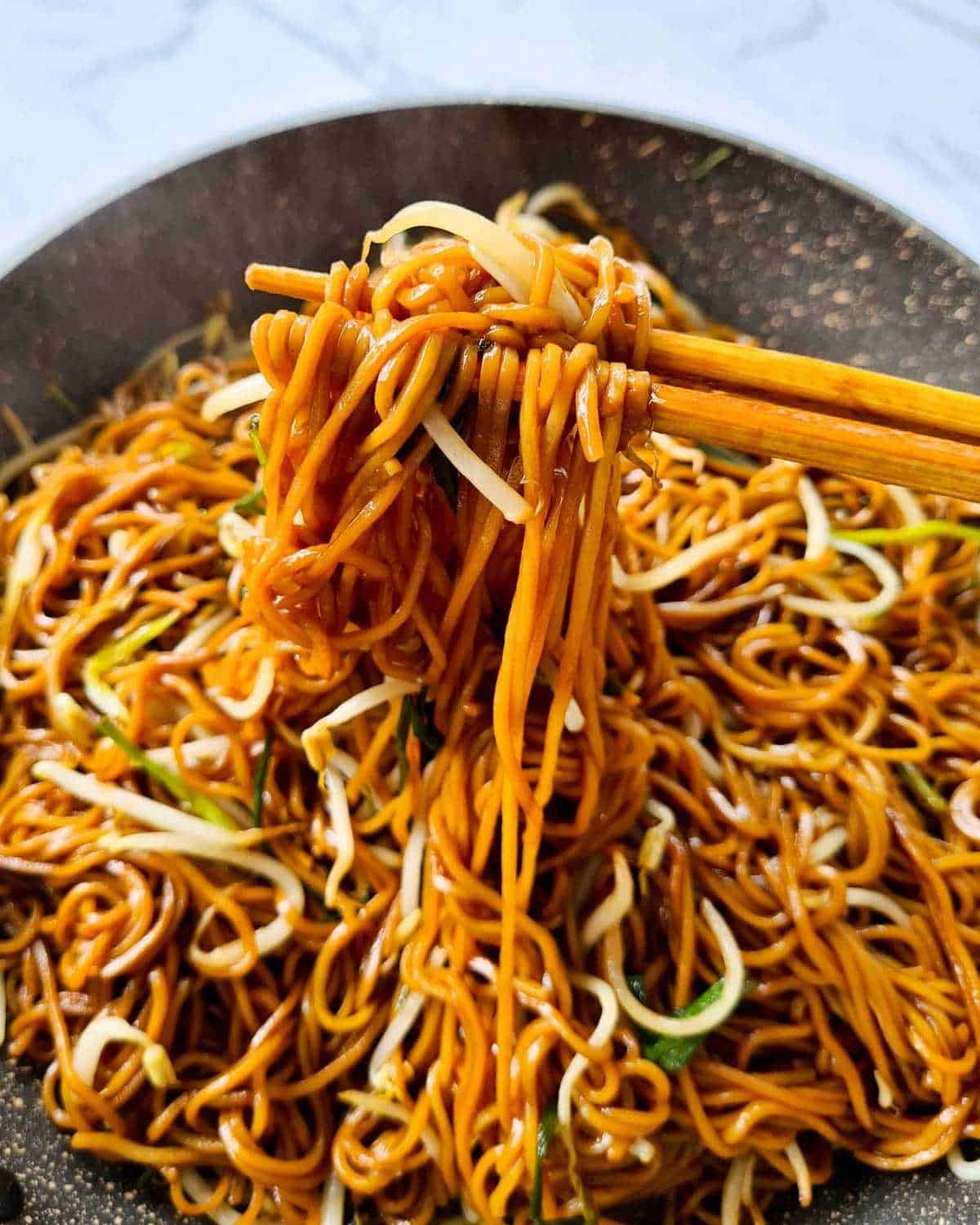
Jump to:
'Wok hei' (air of the wok)
Since these noodles are quite simple (just noodles, spring onions, bean sprouts and seasoning), to maximise its flavours, cooking quickly on high heat is therefore key.
In Cantonese, this is referred to as having 'wok hei' (鑊氣) which is translated as 'air of the wok'. In Mandarin, at home, we call it 'huo chi' (火氣) which is roughly translated to 'breath of fire'. You want the wok (fry pans will work too) to be really hot before you even add in the oil.
Cooking on high heat does wonders and is a must for this soy sauce noodles dish. It caramelises each ingredient and thus adding complexity and depth of flavour.
To learn more, head on over to my Beef Noodle Stir Fry post where I go into more details around the art of stir-frying and how to stir fry meats like a pro using the 'velveting' method!
Ingredients
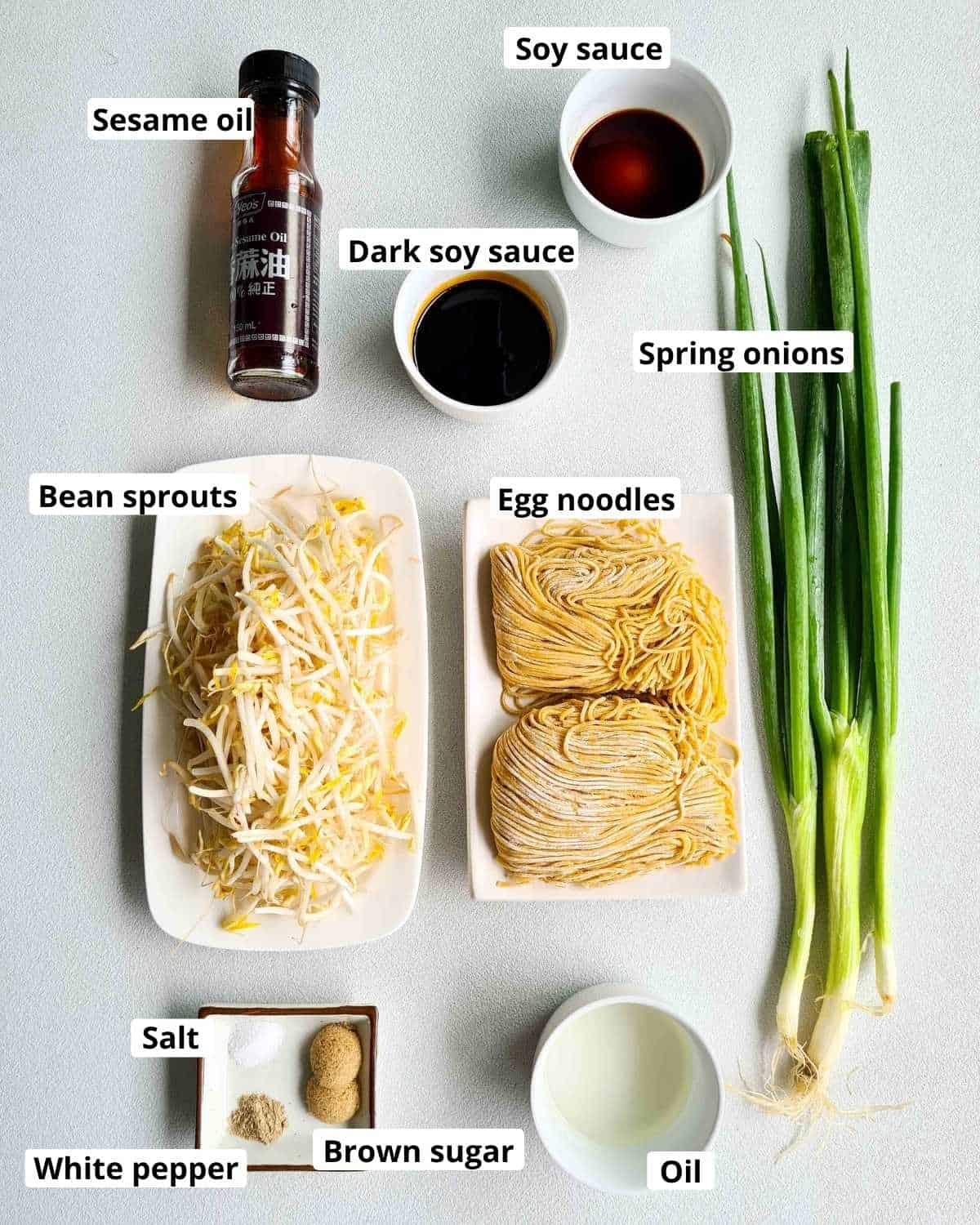
Egg noodles
Thin noodles that contain fresh eggs which add richness and once cooked, has a satisfyingly chewy texture. There are 3 main varieties out there including:
- Fresh uncooked
- Fresh cooked noodles (usually has 'chow mein' written on the packaging and are crinkly in appearance).
- Dried egg noodles (available in the asles, not the fridge section).
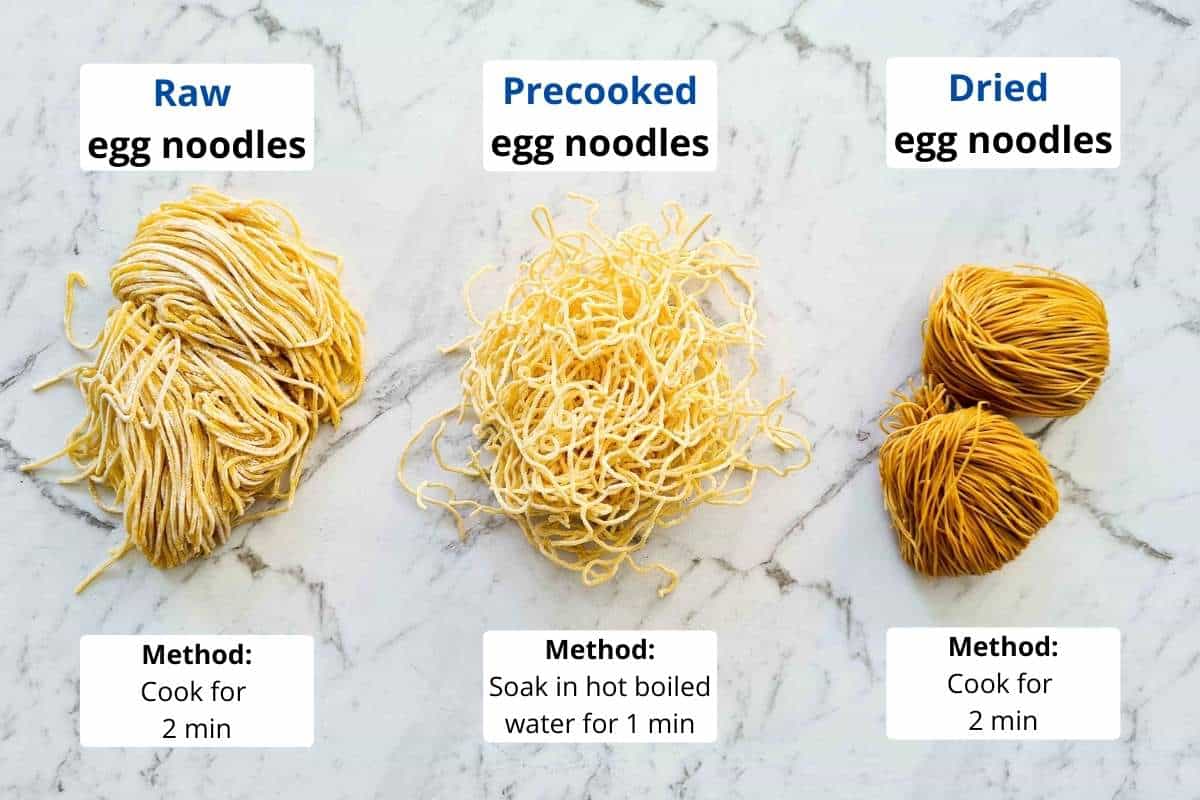
All three are perfect to use for this recipe. Although deviating from the authentic Cantonese style, this recipe will work even with Hokkien noodles!
You can find thin egg noodles at most Asian supermarkets. To my Australian readers, these are also available at quite a few Coles, Woolworths!
Note, Hokkien noodles are also a type of egg noodles however they're much thicker.
Egg noodles vs wonton egg noodles
Generally, when at the fridges of an Asian supermarket, you'll be faced with packets of 'Hong Kong-style egg noodles' and 'Hong Kong-style wonton egg noodles' written on them. Sometimes, the 'Hong Kong-style' doesn't even appear on the packaging and that's completely okay.
They'll look virtually the same; thin, raw, uncooked and coated with cornstarch. Same ingredients. I've no idea what the difference is but I did notice that the wonton egg noodles had a slightly higher egg content (<10% difference). It could be the brand or maybe that's the key distinguisher! Who knows. Anyhow, when in doubt, pick the wonton egg noodles for when you're making Wonton Noodles and for this stir fry, get the one that just says egg noodles.
Remaining ingredients
- Dark soy sauce and soy sauce - adds colour, richness and most importantly, umami (savouriness). Dark soy sauces are stronger in flavour, darker in colour and lighter on salt content than normal soy sauces.
- Bean sprouts - these are mung bean sprouts and are used extensively in East and South-East Asian cooking. Also available at Asian supermarkets otherwise, most fruit and vegetable grocers sell these too!
- Buying tip: look for the freshest sprouts. Bean sprouts are generally sold in bags, in the fridge section. If the spouts are looking a little soft, avoid them. Safe to eat but terrible in salads! Always look for crisp looking ones without any liquid at the bottom of the bag. This is particularly important if you're serving bean sprouts raw such as in Vietnamese Vermicelli Bowls.
- Brown sugar - can substitute with white sugar. Brown is always preferred in all my recipes as they have that extra richness from the added molasses.
How to make pan fried soy sauce noodles
This Canontese chow mein recipe takes just 15 minutes and is very easy with minimal prep required.
Nonetheless, when it comes to stir-fries, preparation is key. Since everything takes just minutes to cook, you want to have everything within arm's reach.
Preparation is key
To begin, wash and trim spring onions (scallions) and then cut them into ~ 6cm/2.5 inches long then thinly slice like the image below.
What this doing is opening up the onions and thus helps with releasing its flavours. In addition, the spring onions will be in similar length and thickness to the bean sprouts which allow even distribution throughout the noodles.
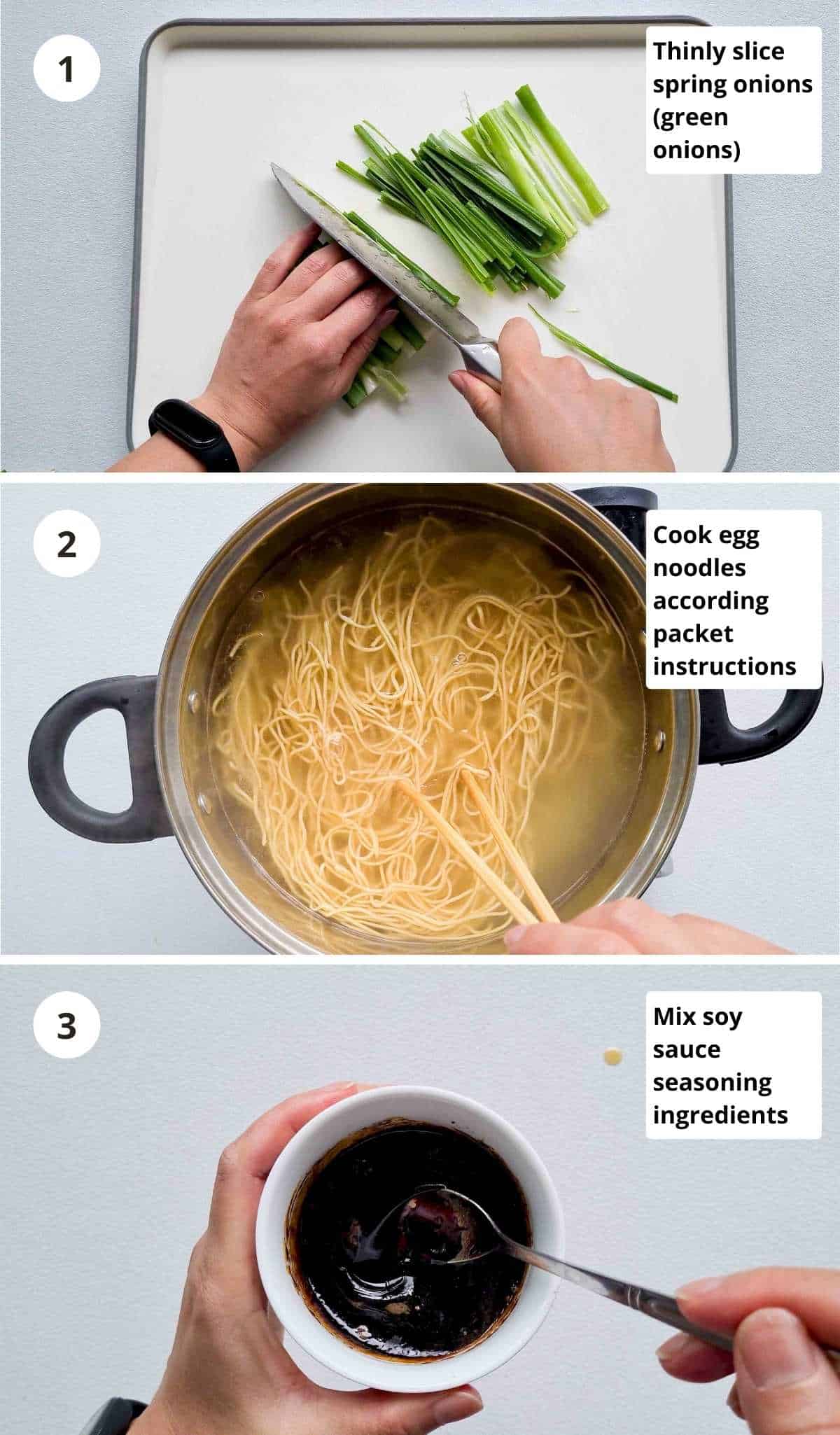
Cook raw egg noodles according to packet instructions, usually takes around 2 - 3 minutes then drain.
If you're using chow mein noodles, they are the crinkly looking egg noodles that are precooked. Prepare according to packet instructions, usually, it is soaking in hot boiled water for 1 minute then drain.
Then, in a small bowl, combine seasoning ingredients: soy sauce, dark soy sauce, sugar, salt, white pepper and sesame oil. Mix well.
Pan fry on high heat
Now that everything's ready to go, time to cook!
Turn the stove on high heat and get the fry pan or wok nice and hot. Fry spring onions with oil until fragrant and lightly golden.
Then, push spring onions to the rims of the pan and add noodles. Toss through on high heat with 2 spatulas, one in each hand. Or, if you like using chopsticks, I use a pair of chopsticks in one hand and a spatula with the other.
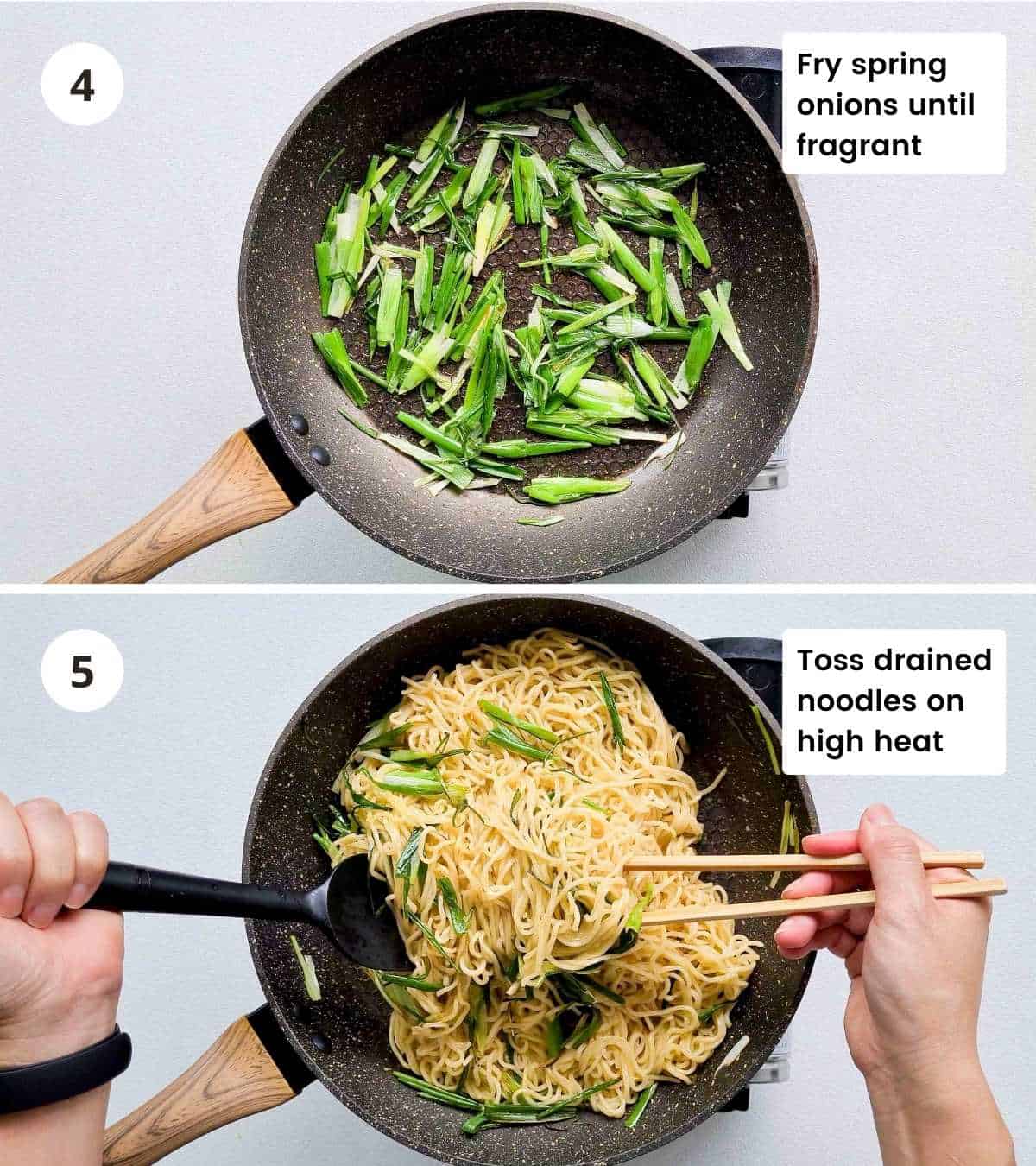
The pan or wok should be sizzling loudly and the point here is adding light caramelisation to the noodles. You don't want to overdo it either, about 1 to 2 minutes is good.
Now, drizzle soy sauce seasoning all over the noodles and continue to toss through and stir fry on high heat for a couple more minutes. Allowing the soy sauces to sizzle and get all that 'wok hei', creates depth of flavour.
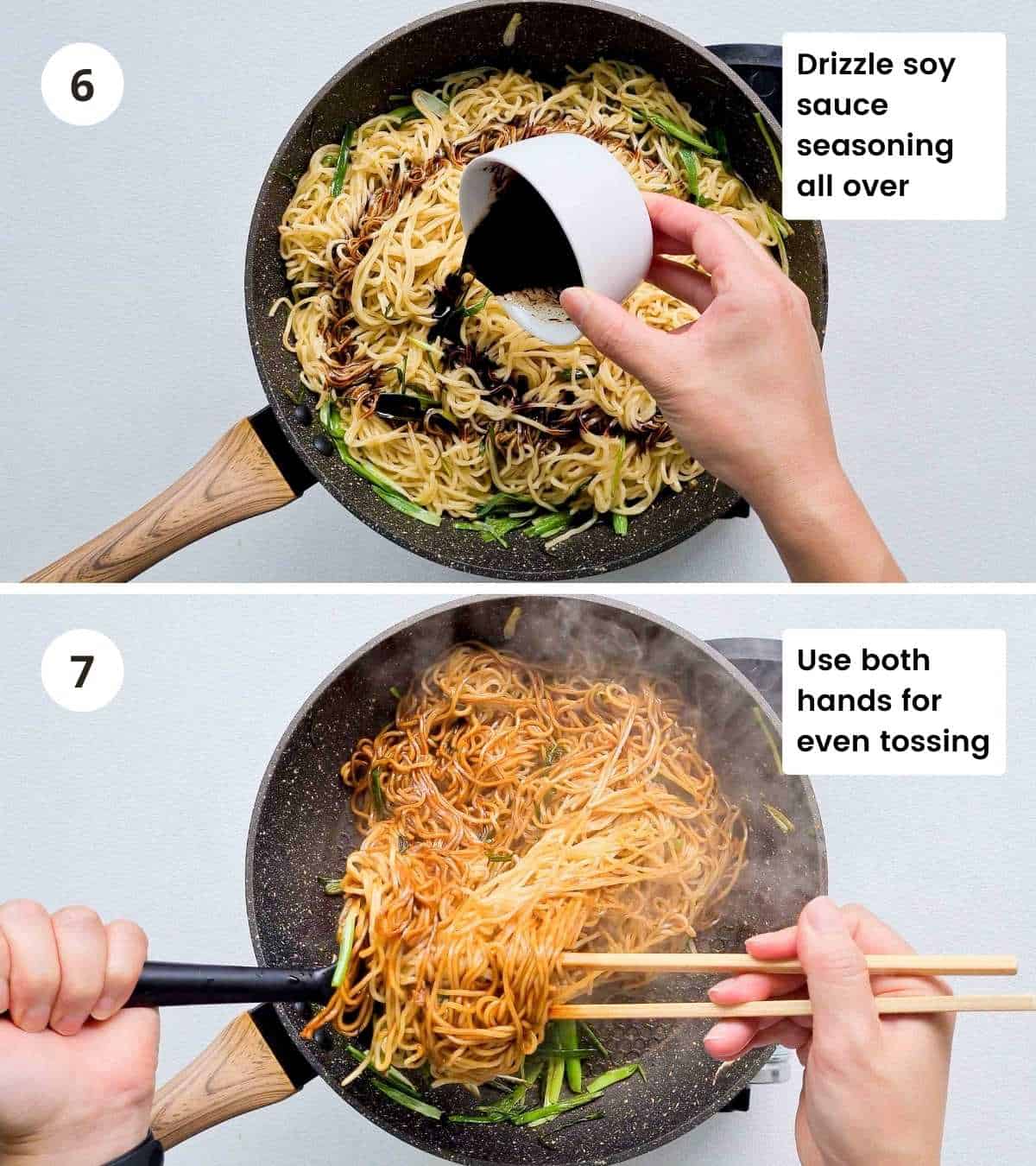
Finally, add in washed and drained bean sprouts and toss through until well distributed amongst the noodles. Bean sprouts add freshness and a light crunch factor.
Did you know that bean sprouts are ~90% water? As it touches heat (and sodium), it'll release its water content very quickly. You'll find the noodles will be even easier to toss through with the addition of moisture from the bean sprouts.
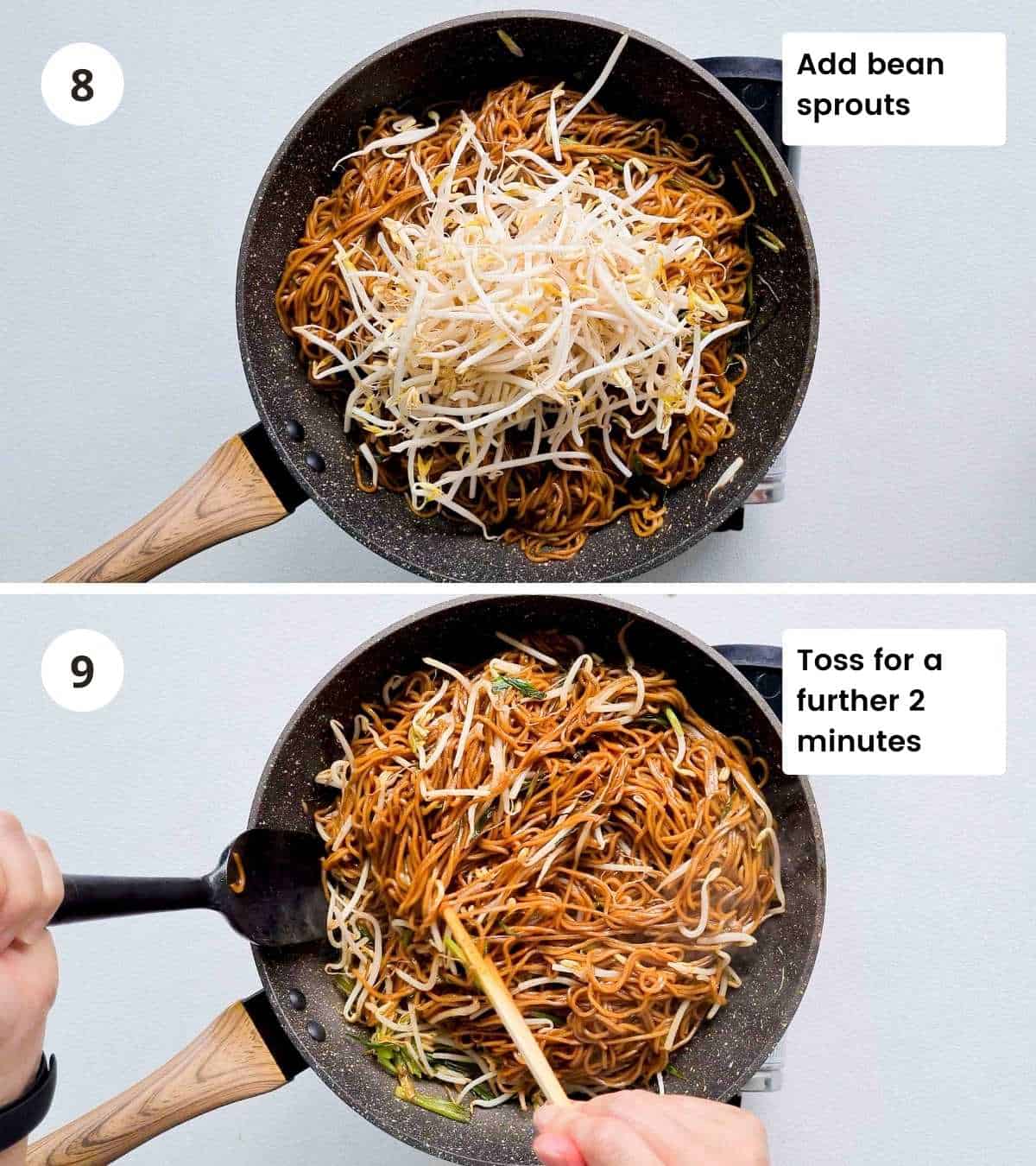
That's it! Takes no longer than 15 minutes from start to finish!
Serving suggestions
Ideas to serve these easy soy sauce noodles with for a complete meal:
- Easy Pork Wontons - super easy wontons with a fool-proof, no experience folding method. Don't worry, I've got a video too to show you exactly how to fold these juicy parcels of yum-ness!
- Vegan Dumplings - continue on the vegetarian streak, pair these noodles with some mouthwatering, veg-packed dumplings!
- 15 minute Butter Garlic Prawns - delicious dinner done in 30 minutes.
- San Choy Bow - healthy, refreshing and super flavoursome. Get adventurous and add a little bit of these soy sauce noodles into the san choy bow! Who doesn't love a fun interactive dinner!?
- Easy Chinese Steamed Fish - fresh and delicate with the classic spring onions and ginger flavour profile.
You'll notice these suggestions have flavours that aren't soy sauce heavy since the noodles are already covered in it. Aim for lighter dishes that compliment the richness of these noodles (in soy sauce)!
For more inspiration, take a browse of all my Asian Recipes!
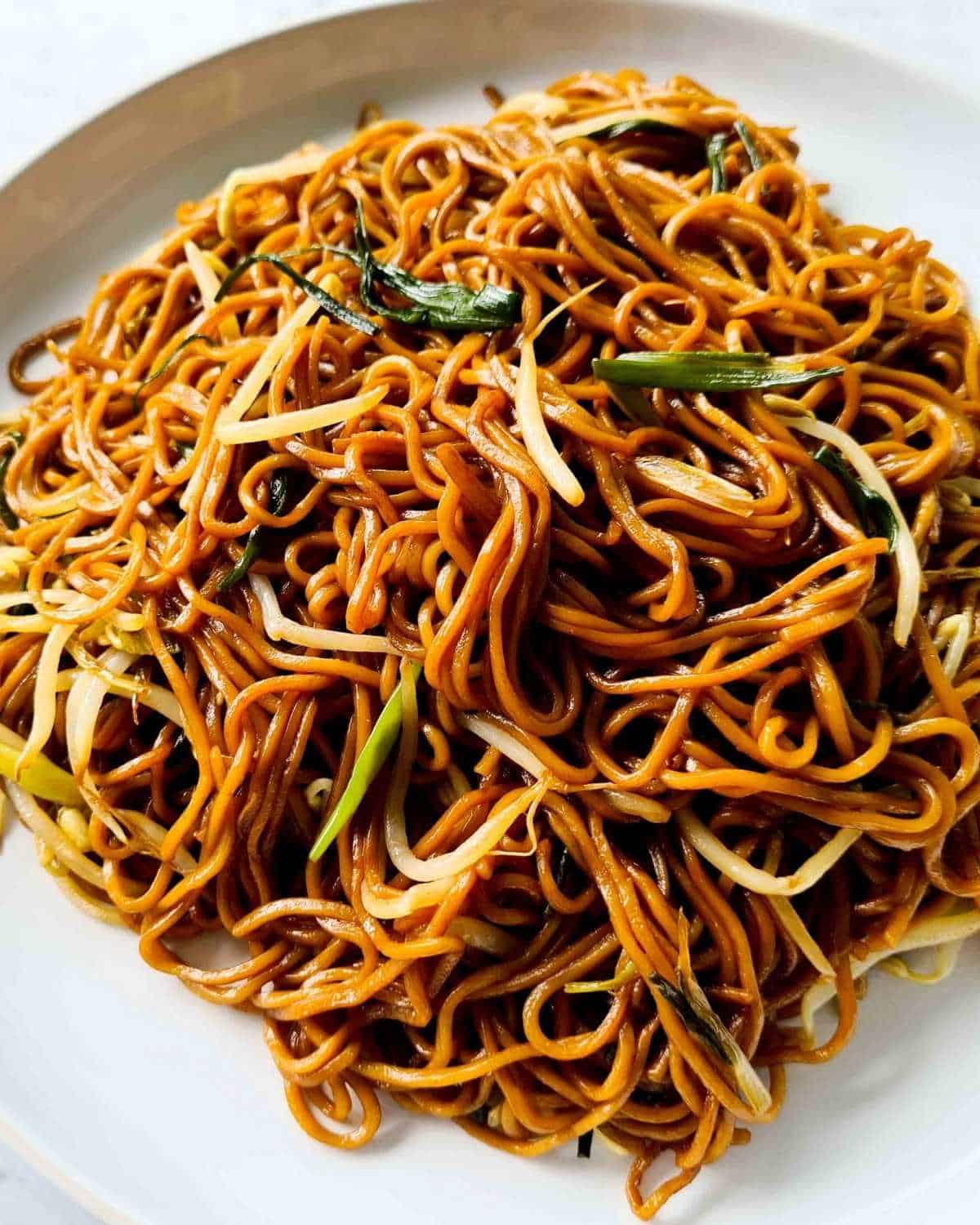
Useful tips and tricks for making soy sauce noodles
- Use a well-seasoned wok and heat it till smoking point before cooking - this is super important if you're using a wok. If the wok isn't well seasoned, the noodles will stick to the bottom of the wok and it'll get real messy, real quick.
- To make life easier, use a non-stick frypan or wok. Non-stick makes stir-frying sooo much easier! Things won't stick to the bottom and you can cook with ease.
- Run the cooked noodles under the tap to loosen before stir-frying. Otherwise, the noodles will be much harder to toss through. Some noodle packaging will suggest mixing drained noodles with a little oil to avoid sticking. I find it super easy to just rinse quickly under some tap water and loosen with a pair of chopsticks.
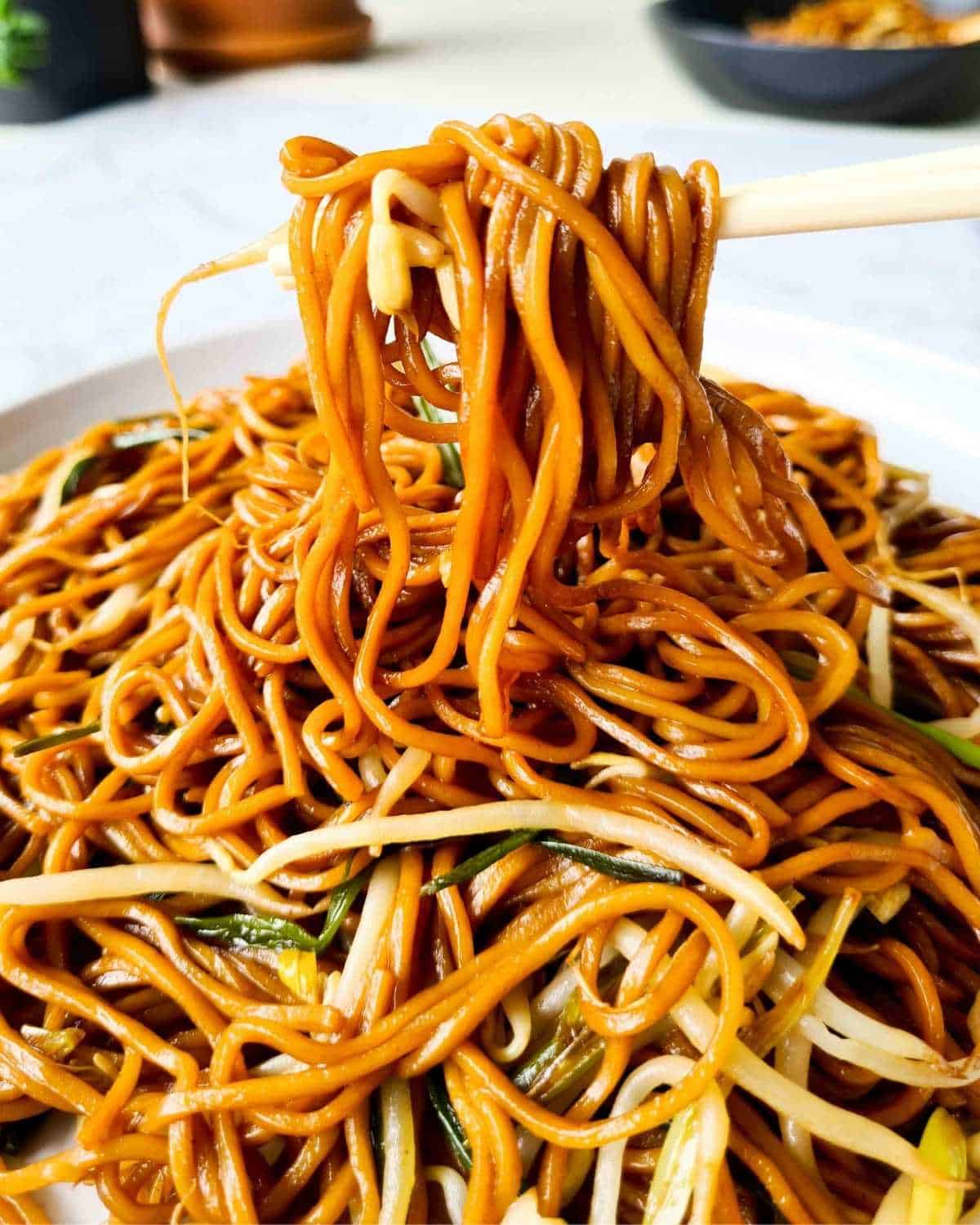
Good to know (FAQs)
Homemade egg noodles are made with flour, eggs, water and salt. In comparison, store-bought fresh Hong Kong-style egg noodles typically contain flour, eggs, wheat gluten, water, sodium bicarbonate, cornstarch, salt, colour and preservatives.
Why not!? The flavour profile will be even more similar if you use fresh egg spaghetti! One key difference will be the texture of the noodles. Angel hair pasta would also be a decent substitute.
Everything in moderation is key to a healthy lifestyle and eating habits. Egg noodles are low in fat but high in carbohydrates. For balance, pair these noodles with vegetables and protein.
Am I hearing lo mien? Lo mien are stir-fried thin egg noodles cooked with vegetables and protein (meat, seafood or tofu)! Get creative and add whatever vegetables you've got at the bottom of the fridge. You can of course pick whatever protein you desire and add that to your noodles.
If you are adding meats or vegetables into this egg noodle recipe, I'd suggest adding the noodles in last (so stir-fry the veg and meats). Also, be sure to season well! Be it a little more soy sauces or more salt.
Leftovers/freezing
Any leftovers, store in airtight containers and will last for up to 5 days in the fridge or up to 2 months in the freezer.
Made this recipe? Let me know your thoughts or questions by dropping a note in the comments section below! I'd love to hear from you. 🙂
Happy cooking! - Gen
Video
📖 Recipe
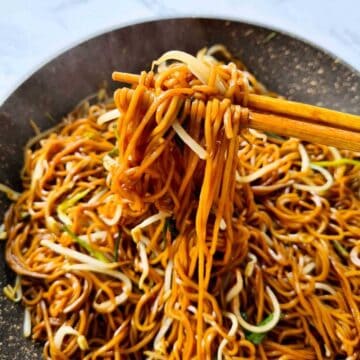
Soy Sauce Pan Fried Noodles (Cantonese Chow Mein)
Ingredients
- 350 g / 12 ounces fresh thin egg noodles or 4 small bundles of dried (note 1)
- 3 cups bean sprouts washed, drained (note 2)
- 3 spring onions (green onions) or 4 small ones
- 1½ tablespoon neutral tasting oil or peanut oil
Soy sauce seasoning
- 1 tablespoon dark soy sauce
- ½ tablespoon soy sauce
- 2 teaspoon brown sugar or white
- ½ teaspoon sesame oil
- ¼ teaspoon white pepper
- ¼ teaspoon salt
Instructions
- Trim and cut spring onions into 6 cm (2½ inches) long then thinly slice lengthways.
- Combine soy sauce seasoning ingredients in a small bowl, mix well.
- Cook egg noodles according to packet instructions then drain. Usually, this takes about 2 - 3 minutes.
- In a large, non-stick frying pan (or wok if using), saute spring onions until lightly golden and aromatic. About 1 - 2 minutes.
- Push spring onions to the rims of the pan then add drained noodles and toss through on the highest heat. You might need to loosen the noodles before adding them to the pan (note 3). About 1 minute.
- Drizzle in soy sauce seasoning and toss through for about 1 minute until the seasoning is well distributed amongst the noodles.
- Add in bean sprouts and toss through for a further 2 minutes.

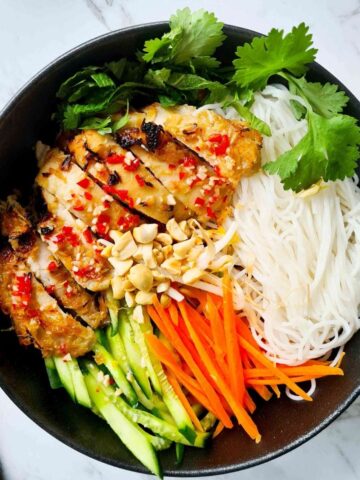
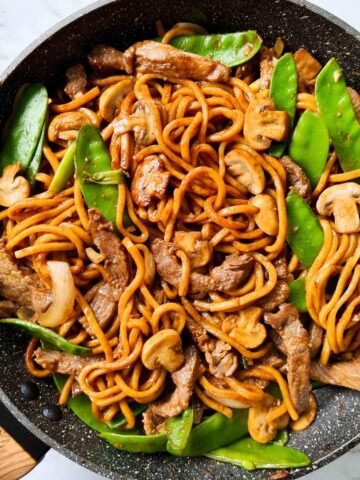
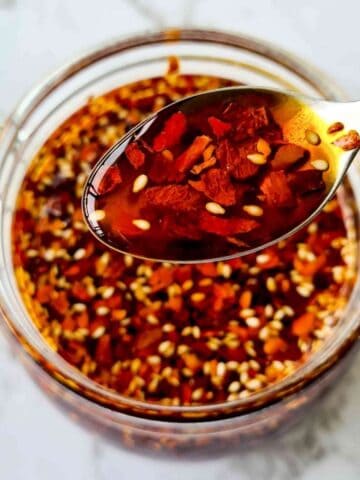
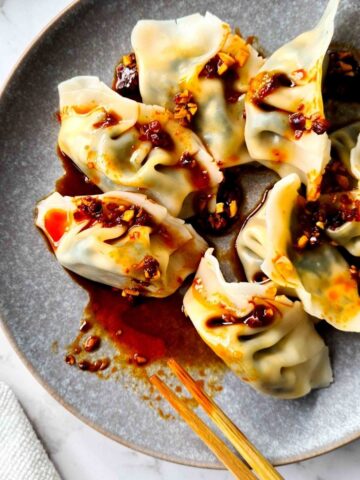
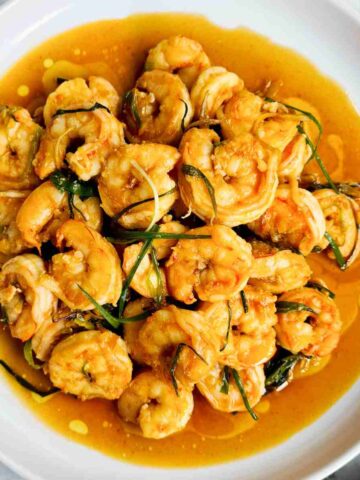
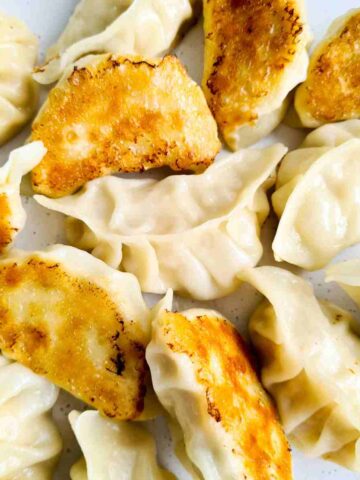
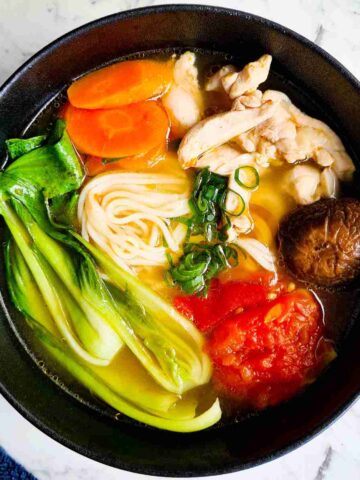
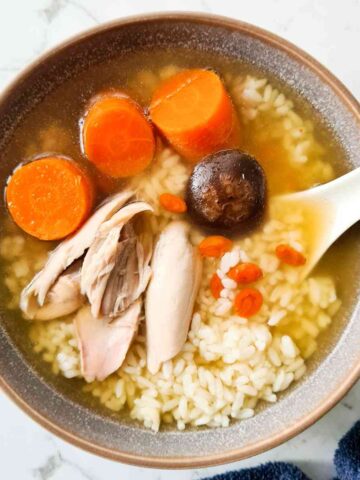
Cindy Spalding
Everyone loved this recipe. We didn’t have bean sprouts, but chose to chop and sauté 1/2 can chopped hearts of palm. My 14 year old said this was better than fried rice and asked that next time we make this, we add a raw egg on top.
Genevieve
Very glad to hear that Cindy! Thank you for sharing!